Based on:
Earth Democracy: Connecting the Rights of Mother Earth to People’s Rights and the Well-being of All, Navdanya, Mother Earth Day, 2021
Author: Dr Vandana Shiva with Navdanya Team
Earth Rising
The denial of nature’s rights has led to destruction of nature and now threatens the very conditions of human survival. The multiple crises we face today – the health pandemic, the hunger pandemic, the poverty pandemic, the climate emergency, the extinction emergency, the emergency of injustice, exclusion and inequality, dispossession and disposability of large numbers of humanity – are all rooted in a world view based on the illusions of separation and superiority which deny interconnectedness and oneness.
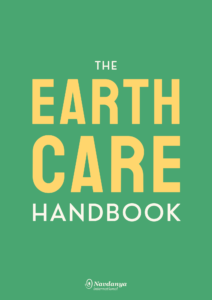 In an ecologically interconnected world, denial of the rights of nature translates into denial of human rights, as the same constructs that lead to violence against nature and her destruction, are the basis of violence against fellow human beings. Non-sustainability and injustice are part of the same process, as this worldview of separation also engenders hierarchies and the illusion of superiority – separation and superiority create structures of violence.
In an ecologically interconnected world, denial of the rights of nature translates into denial of human rights, as the same constructs that lead to violence against nature and her destruction, are the basis of violence against fellow human beings. Non-sustainability and injustice are part of the same process, as this worldview of separation also engenders hierarchies and the illusion of superiority – separation and superiority create structures of violence.
These multiple emergencies are not separate, they are interconnected, and they have the same roots. Their solutions are also interconnected. However even though the crises are interconnected, each crisis is treated as unrelated to the others. There is a focus on symptoms, and not the deeper root causes. The emergencies that threaten the very future of our species cannot be addressed by the same mindset that created them. The current corporate hijacking of the transformation of food systems, epitomized through the upcoming UN Food Systems Summit is an example of the same mindset proposing solutions to the problems caused by it. A lack of acknowledgement of the necessity for Earth Rights in conjunction with people’s rights risks the continuation of these structures of separation and a greater accumulation, acceleration and augmentation of these crises.We need a new way of thinking and living that recognizes the principles of Earth Democracy so humans and other species can continue to live and thrive.
Earth Democracy: Recognizing the Rights of Nature, Respecting People’s Rights
Earth Democracy is a worldview, paradigm and practice that is based on the recognition that everything is interconnected, the Earth Is Living, the Earth has rights, that we have a duty to care for the Earth. We do this by regenerating her soil, seeds, biodiversity, her water and food systems. Our rights flow like a spring from these duties.
Earth democracy recognizes that:
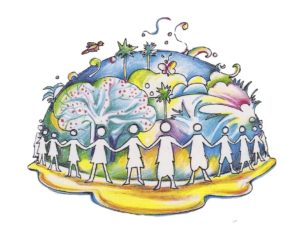 The Earth is living. All ecological problems have common roots in the denial of the Earth as a Living System.
The Earth is living. All ecological problems have common roots in the denial of the Earth as a Living System.
We are alive because nature is alive. The Earth gives us life. We are intrinsically part of the Earth as we are deeply interconnected through the living currencies of breath, water, and nourishment. Since we depend on nature for sustenance, destruction of nature translates into violation of human rights to food and water, life and livelihood. Human Rights are therefore connected to the Rights of the Earth and the Rights of other species as we all have equal rights to food, water, clean air and a safe and healthy environment.
We do not give Rights to Nature. Mother Earth intrinsically has rights. We have to recognise and live according to her laws.
Earth Democracy is based on Living Economies, Living Democracies and Living Cultures woven through their diversity into the web of life. Each life form supports and sustains all others in mutuality and cooperation and harmony. Our society, and economy should reflect this. In Earth Democracy the economy is a subset of ecology based on the laws of Mother Earth.
All humans are equal. Our diversity enriches life and cannot be made the justification for inequality and injustice. Imposition of sameness and uniformity on a biologically and culturally diverse world unleashes violence against nature, her species, and diverse cultures.
Future generations have a right to enjoy the gifts of the Earth. Present generations have a duty of Earth Care to pass on the gifts of nature in their full diversity, integrity, and purity.
A movement is growing to define violence against nature and violation of principles of ecological justice as a crime of Ecocide in international law. Across the world people are taking actions to prevent the damage to and destruction of ecosystems which are harming the health and well-being of species, including humans.[1]
Ecological Agriculture is Earth Care
Earth democracy as a world view and practice allows us to recognize the connections between the Rights of Mother Earth and People’s Rights and gives us a path to walk in order to protect both. Central to this path is agriculture as Earth care. Combining respect for the Earth with justice for farmers, their right to their resources– seeds, land, water, knowledge –the right to an independent, sovereign livelihood and the right of all people to healthy, chemical free food; enshrined in the Right to Food and the Right to Health.
When we practice agriculture in unison with the Earth’s ecological processes, and in alignment with the ecological laws of nature, we evolve an agriculture of care for the land and for the soil. It is an active participation in the processes of regenerating seed and biodiversity, soil and water. As it is through practicing the law of return that we become part of the great nutrition and food cycle that sustains all life on Earth.
But this is only possible when we see ourselves as active members of one Earth family. Other species are not objects to be manipulated, exploited or pushed to extinction but are our relatives. Each plays a vital role in maintaining and regenerating the web of life. Scientists are now finding out that cooperation shapes evolution, not competition– from the molecules in a cell, to organisms, ecosystems and the planet as a whole, cooperation and mutuality is the organizing principle of life.
Rejuvenating and regenerating the planet through this participation in reciprocity with ecological processes has become a survival imperative for the human species and all beings. What we eat, how we grow the food we eat, and how we distribute it, will determine whether humanity survives or pushes itself and other species to extinction. When we farm with real knowledge of how to care for the Earth and her biodiversity, when we eat real food which nourishes the biodiversity of the Earth, our cultures, and our gut microbiome, we are then participating in real and living economies that regenerate the well-being of all. This is how we sow the seeds of our future.
It is stepping back onto the path of life which has sustained humanity in its diversity over millennia. Each community and culture have co-evolved their own distinct path according to their climates, soils, and biodiversity, contributing to the diversity of food and farming systems. The diversity of cultures of food and agriculture are united through the common and perennial principles on which life is based:
The first is the principle of diversity. Nature does not work on the principle of sameness, uniformity, and monocultures. The natural world is a constant striving for diversity of expression. The cultural diversity of food and agriculture flows from nature’s ways and her biodiversity.
The second principle is the “law of return” or giving back in gratitude, to maintain nature’s ecological cycles of nutrients and water, which are nature’s circular economies on which all life depends.
The third principle is sharing the Earth’s gifts in the commons, which flows from nature’s laws. Since life is a web based on interconnectedness, no part of nature belongs to one species. In the paradigm based on nature’s principles of how life works, food is not a commodity. Nature creates abundance. Human beings cocreate abundance when they work according to Nature‘s Laws and in cooperation with each other.
These principles have created food systems that have lasted over centuries. And all over the world, small farmers and gardeners are already implementing this agriculture: preserving and developing their soils, their seeds and practicing agroecology. They are feeding their communities with healthy and nutritious food while also rejuvenating the planet. They are, thus, sowing the seeds of Earth democracy by creating a food system in the hands of farmers and consumers, devoid of corporate control, poisons, food miles and plastics. In this way, ecological agriculture/agroecology has the potential to emerge as our most important path to defend the Rights of Mother Earth.
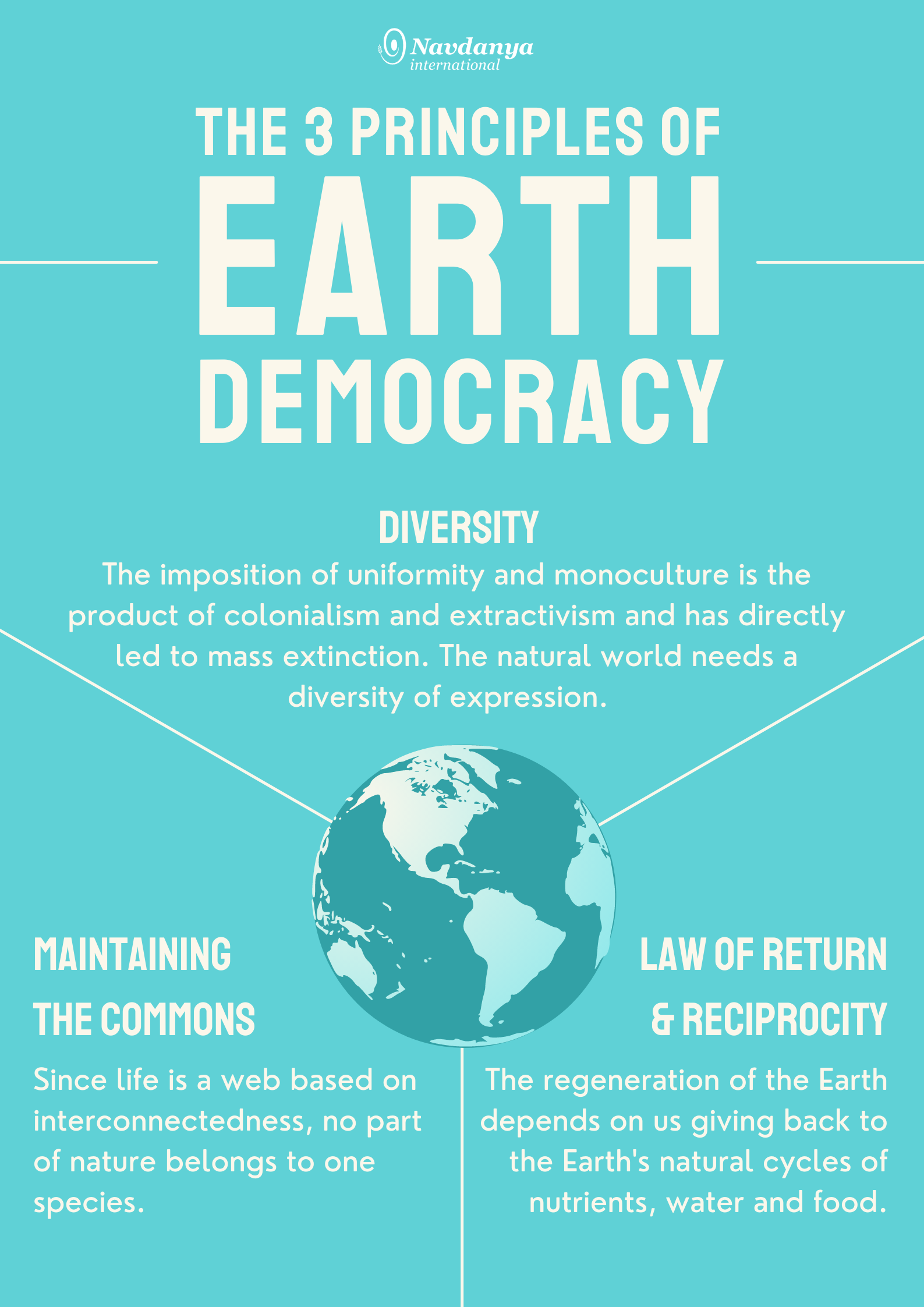
The Industrial, Globalized Food System is at the root of multiple emergencies
We are facing a triple crisis that threatens our planet and our food system.
The first is the ecological crisis including: the disappearance of biodiversity and species; climate change, instability, and extremes; soil erosion, land degradation, desertification; water depletion and pollution; environmental toxicity and the spread of toxics throughout the food system. Most of the planetary destruction to soil[2], water[3], biodiversity[4] comes from industrial agriculture and has contributed to around 50% of the total greenhouse gas emissions[5]. A large percentage of crop diversity has been pushed to extinction through industrial agriculture[6]. Commodification of food has reduced the crops cultivated to a dozen globally traded commodities[7], while hundreds of species are disappearing daily.
The second is the public health crisis of hunger and malnutrition, pandemics, and the non-communicable chronic disease epidemic. This is due to the production of nutritionally empty or toxic commodities causing more than 70% of global deaths due to noncommunicable diseases from food related diseases[8]. Industrial agriculture has pushed 690 million people and rising into permanent hunger[9], with half the hungry being farmers. Pandemics also have their roots in the limitless expansion into forests by agrobusiness to grow commodities.[10]
The third is the crisis of livelihoods of farmers, the epidemic of indebtedness and farmers’ suicides because of high-cost inputs, and their displacement due to degradation of land, desertification, and disappearance of water. The industrial path has been paved with the false assumption that external inputs are necessary. Farmers are being forced to spend up to more than they can earn, using more energy than they can produce as food.
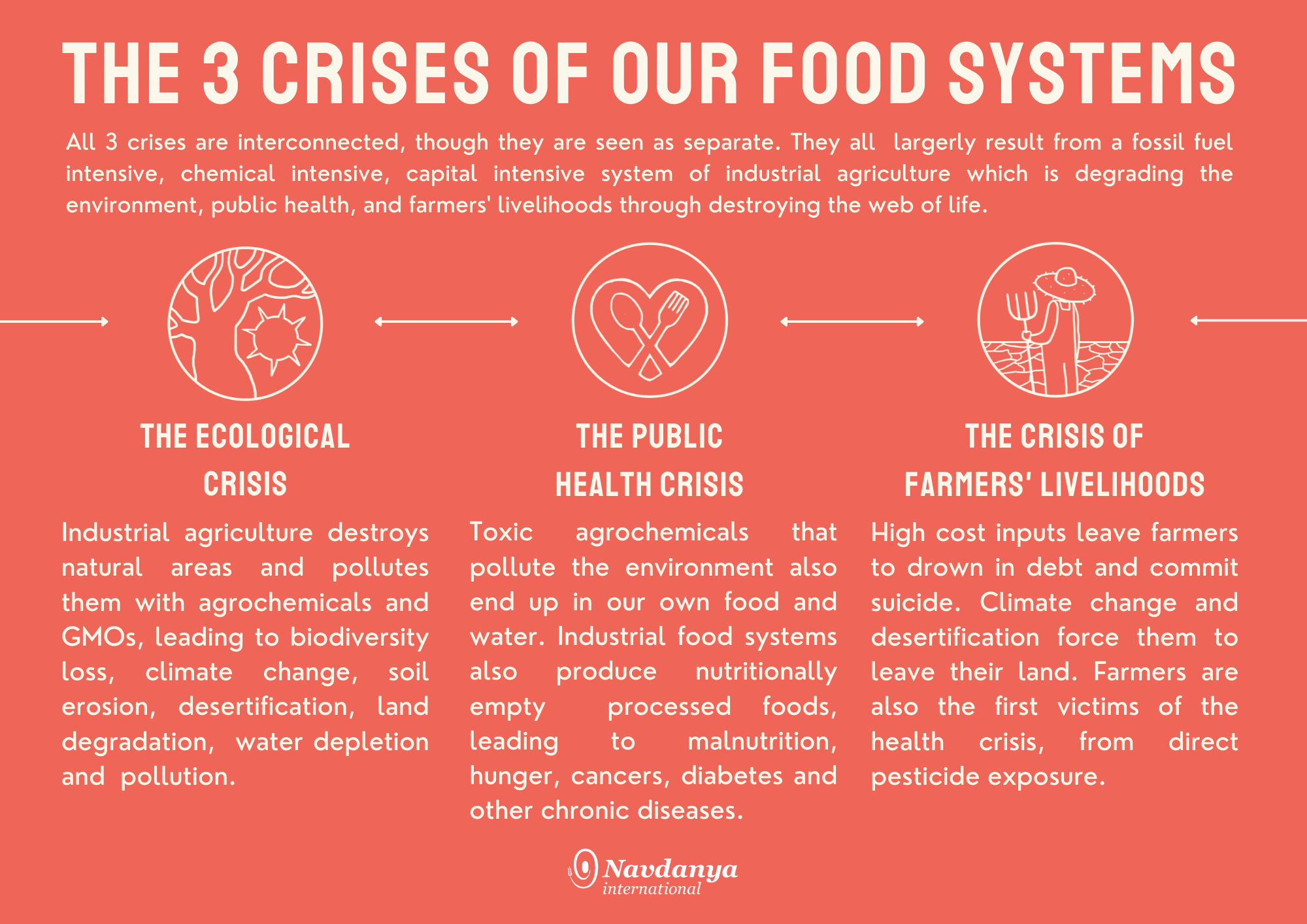
All three crises are interconnected, though they are seen as separate. And the most significant contribution to all three crises comes from a fossil fuel, chemical and capital-intensive system of non-sustainable industrial agriculture. This system of agriculture destroys the Earth’s capacity to create, maintain and regenerate living processes that sustain life and is connected to the destruction of the human potential to live and meet basic needs. The industrial path is the path of violence against the Earth and people.
Instead of correcting the false assumptions of industrial agriculture that nature as dead inert matter and mere raw material to be extracted to prevent the ecological, social and health emergencies, Big Ag, Big Tech, Big Finance want to further fragment farming and further extract from nature by further centralizing control to further expand large farms that are ecologically, economically, and energetically inefficient, and further promote a fake science of sustainability. Under the guise of offering us the cure to their disease, the new language of ‘Nature Based Solutions’, ‘Half for Earth’, or ‘Climate-Smart’ continue to deepen this Anthropocentrism, Eco-apartheid and instrumentalization of nature as false solutions to the planetary crisis. New proposals by the very companies who created these multiple crises to address the ecological emergencies are neither sustainable, nor just. They deny both the Rights of Mother Earth and people’s rights through a new green washed extractive economy.
For example, carbon offsets and the new accounting trick of net zero carbon does not mean zero emissions. It means the rich polluters will continue to pollute, and also grab the land and resources of those who have not polluted – indigenous people and small farmers – for carbon offsets. Carbon trade continues to violate nature’s rights by denying the integrity of the Earth’s ecological processes.
On the other hand, the idea of Farming without Farmers and fake food without farms is a continuation of the false assumption that we are separate from nature, that we can live outside the Earth’s life-giving processes, and we have no duty to give back to her cycles.[11] It is also a denial of the disease burden caused by industrial agriculture and industrial ultra-processed food. Having exacerbated the pandemic and the chronic disease emergency through chemical and ultra-processed foods, the dystopian vision of Big Tech and Big Ag is to reduce agriculture to producing carbohydrates and proteins as raw material for fake food. Lab food is hyper processed food. This is a denial of the fact that health is a continuum from the biodiversity in the soil, of our plants and in our gut microbiome. Destruction of biodiversity contributes to disease and sickness for the Earth and her beings, including humans.[12] The planet’s health and our health are non-separable.
By destroying the web of life, the industrial food system is at the heart of the planetary crisis and the human crisis. It goes against the principles of nature and life. It violates the principle of diversity and imposes monocultures and uniformity. It violates the principle of giving back and extracts from nature and farmers, disrupting ecological sustainability and social justice. It is the path to extinction and climate catastrophe, and the spread of hunger, malnutrition, and chronic diseases.
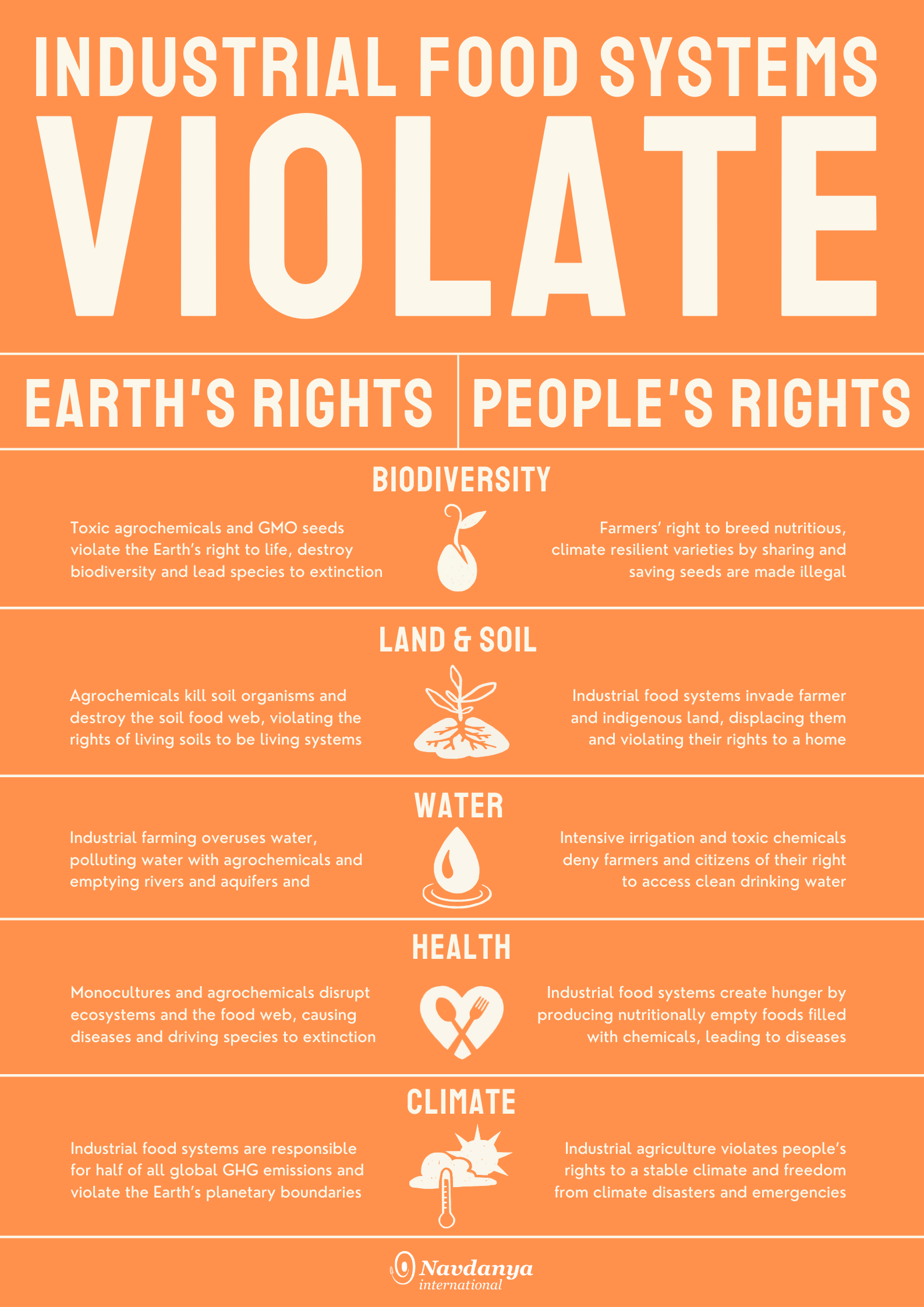
Principles of the Rights of Mother Earth
Living Seed
Corporations have sought to commodify and take control of this living element through laws and patents that give them intellectual property rights and breeders rights over the seed, and through seed laws that extend the industrial criteria of uniformity on farmers’ and open pollinated varieties of seed. These legal instruments prohibit the free exchange of seed between farmers, and their ability to breed, save and distribute seeds. Despite calls from India and the African Group of nations to revoke the ability to patent any life forms, the mandatory review of the TRIPs has been subverted by governments under the influence of corporations.
The dominant system of seed related laws fails to understand the nature of the seed as the embodiment of the evolutionary process of nature over millennia, and of farmers over thousands of years. It does not consider, or allow for, the vibrant, holistic, and ecologically embedded system that gives rise to diversity and resilience. Owning life by claiming it to be a corporate invention is both ethically and legally wrong.
We must seek to protect this most fundamental element of life to bring back biodiversity, health, and to restore democratic systems within our society. The Law of the Seed puts sustainability and Earth and people’s rights at the center of the scientific and legal frameworks that govern the seed, in place of the current trend of monocultures and monopolies, uniformity and privatization, corporate control and criminalization of biodiversity and farmers.
The freedom to save and exchange seed is vital in our time characterized by multiple crises and comes out of an ecological and democratic imperative for the long-term future of the planet and of its inhabitants.
Living Soil
Both ecological science and ancient wisdom teaches us that all life depends on soil. Living Soil is a complex food web teeming with life. This life in the soil is what rejuvenates soil fertility and makes nutrients available to plants to support our agriculture.
Yet the agricultural industry adopted the myth that synthetic fertilizers can increase food production independent of soil life. This myth is supported by the construct of yield – a measure of the weight of the commodity that leaves the farm. It is not a measure of the nutritional value of food produced from the land, nor does it take account of the condition of the land after harvest. The use of artificial fertilizers has resulted in the death of soil life and reduced soil fertility. Nutrition per acre has decreased. The cycling of carbon and nitrogen through the soil has been disrupted. Chemical agriculture needs ten times more water to produce the same amount of food as organic farming, contributing to water scarcity and desertification, and creating dead zones in the ocean through pollution. Over time, the impoverishment of the soil and soil life leads to increasing reliance on greater volumes of chemical fertilizers, impoverishing farmers, and creating famines and food crises. This is the exact opposite of what the myth promised to create.
The only way to farm sustainably is to farm according to nature’s law of return. The Law of the Soil is the Law of Return as returning organic matter to the soil to feed the soil biology and build up soil nutrients. Soils high in organic matter, supported by biodiversity of flora and fauna, are more resilient to drought and climate extremes. They take carbon out of the atmosphere, storing it in plants and in the soil. It is through care for the soil, and the living organisms within the soil, that we produce nutritious, healthy foods, prevent the pollution of our water, air and soils, and thus build the health of people and of the environment.
Living Water
Water is a commons and it is the ecological basis for all life. However, there is a growing momentum towards the privatization of water resources. Giant water projects, such as big dams, have shifted water control from communities to central governments. In most cases, these projects benefit the powerful – construction companies, industries and commercial farmers – while dispossessing communities. Through the rhetoric of privatization, we see increasing intervention by the state in water policy, and the subversion of community control over water resources.
In the pursuit of profit and economic growth, governments have sold water rights to industries and corporations, without ensuring the appropriate responsibility and accountability for maintaining that resource in a clean and natural state. The pollution of rivers through the leaching of synthetic fertilizers and erosion has created dead zones in our oceans, killing marine and aquatic life and fundamentally damaging the natural hydrological cycle.
Principles of Water Democracy
1. Water is nature’s gift. We receive water freely from nature. We owe it to nature to use this gift in accordance with our sustenance needs, and to keep it clean. Diversions that create arid or waterlogged regions violate the principles of ecological democracy.
2. Therefore, Water is a commons. Water is not a human invention. It cannot be bound and has no boundaries. It is by nature a commons. It cannot be owned as private property.
3. Water is essential to life. Water is the source of life for all species. All species and ecosystems have a right to their share of water on the planet.
4. Life is interconnected through water. Water connects all beings and all parts of the planet through the water cycle. We all have a duty to ensure that our actions do not cause harm to other species and other people.
5. Water must be free for sustenance needs. Since nature gives water as a gift free of cost, buying and selling it for profit violates our inherent right to nature’s gift and denies the poor their rights to water.
6. No one has a right to overuse, abuse, waste, or pollute water systems. Tradable- pollution permits violate the principle of sustainability, doing so results in ecocide.
7. Water must be conserved. Everyone has a duty to conserve water and use water sustainably, within ecological and just limits.
8. Water cannot be substituted. Water is intrinsically different from other resources and products and therefore cannot be treated as a commodity.
Living Food
Grown organically, in living soils, with methods that support biodiversity and the health of our environment, nutrient-rich, chemical-free food is the basis for our health.
Yet industrial food systems, supported by chemical agriculture, have demoted food to a basic commodity, separating and reducing food to its nutrients, and then substituting fake ingredients that are reconstituted in a lab producing fake food. The combination of agrichemicals, synthetic ingredients and industrialized agriculture and food processing contributes to both the environmental crisis and the global epidemic of chronic disease. The resulting consequences force people into health care systems to treat disorders that should be prevented through good nutrition and a healthy environment.
The beneficiaries of this system of disease and treatment are corporations; the merger of Bayer and Monsanto implies the same corporations whose chemicals and destruction of the environment cause disease are profiting from the treatment of those diseases. Governments need to take cancer and chronic disease as seriously as they have the Coronavirus pandemic. This means taking action to ban chemicals that cause harm, including carcinogens like glyphosate and acting against agricultural systems that pollute and destroy our environment.
Health for all beings is based on protecting the Earth and her ecological processes, recognizing that health is a continuum: from the soil and its microbiology to plants, food, and the environment to our gut biome. Ecological, chemical-free agriculture needs to be part of the rejuvenation of public health.
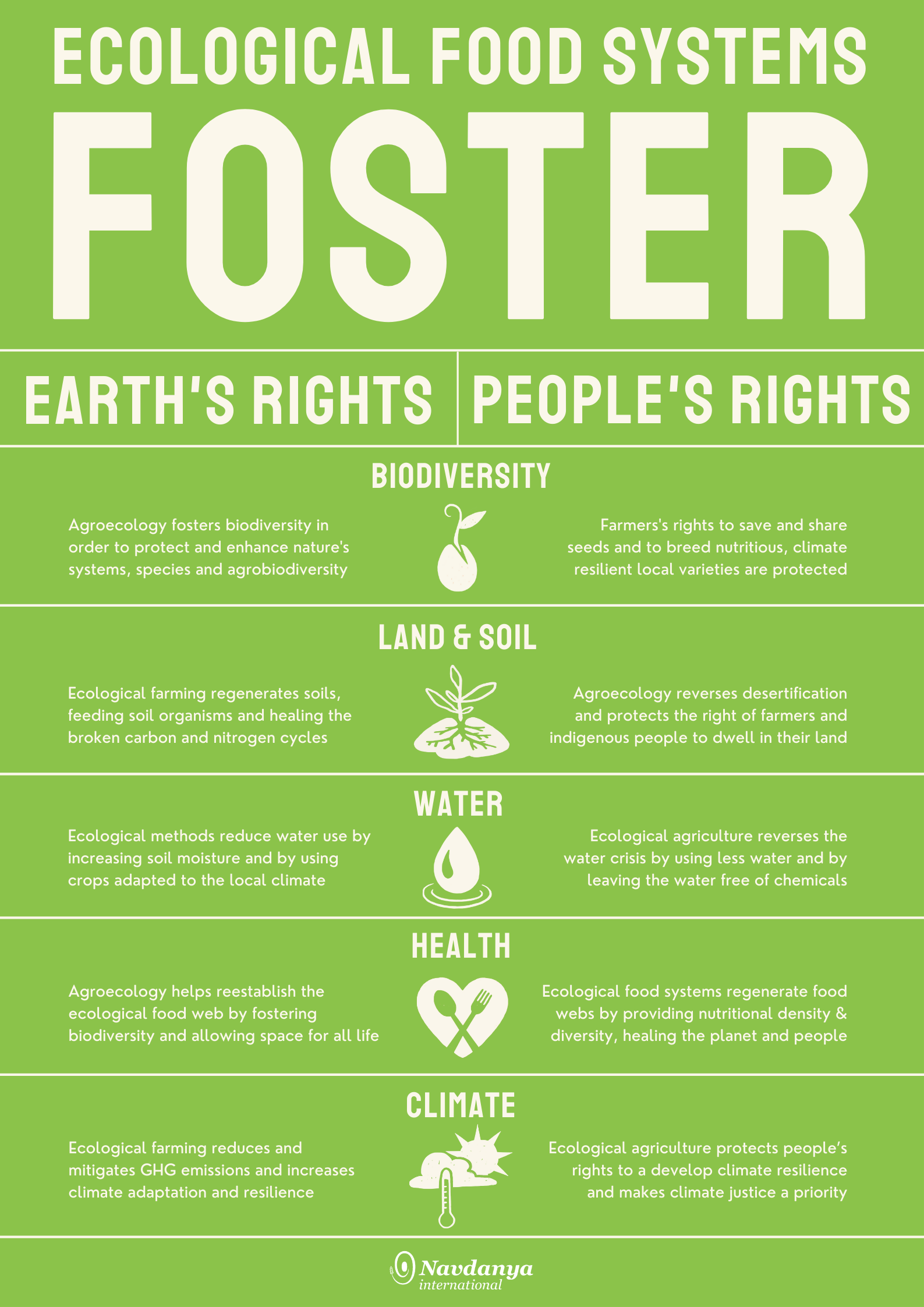
© Navdanya International 2021
Navdanya International
Via Marin Sanudo 27, 00176 Rome
Piazzale Donatello 2, 50132 Florence Italy
Contacts: info@navdanyainternational.org – www.navdanyainternational.org
References
[1] ‘Our International Petition’. Stop Ecocide, https://stopecocide.Earth/become
[2] “Hungry for Land – Small farmers feed the world with less than a quarter of all farmland”, Grain, May 2014.
[3] FAO, “More people, more food… worse water? – Water Pollution from Agriculture: a global review”. 2018. www.fao.org/documents/card/en/c/CA0146EN
[4] Etc Group, “Who will feed us?”, Third Edition, 2017, https://www.etcgroup.org/whowillfeedus
Eswaran, H., Lal, R., Reich, P.F., “Land degradation: an overview” in Bridges, E.M. et al, “Responses to land degradation”, Proc. 2nd. International Conference on Land Degradation and Desertification, Khon Kaen, Thailand, Oxford Press, 2001.
[5] “Food and Climate Change: The Forgotten Link.” Grain, September 28, 2011. https://www.grain.org/e/4357
[6] FAO, and Commission on Genetic Resources for Food and Agriculture. 2019. In The State of the World’s Biodiversity for Food and Agriculture, ed. J. Bélanger and D. Pilling. Rome: Food and Agriculture Organization of the United Nations. http://www.fao.org/3/CA3129EN/CA3129E
FAO 2010. The Second Report on the State of the World’s Plant Genetic Resources for Food and Agriculture. Rome. http://www.fao.org/3/i1500e/i1500e.pdf
[7] Navdanya International. 2013. The Law of the Seed. Florence: Navdanya International. https://www.navdanya.org/attachments/lawofseed.pdf.
[8] Food for Health Manifesto. 2019. Cultivating biodiversity, cultivating health. New Delhi, Rome: International Commission on the Future of Food and Agriculture; Navdanya International. https://navdanyainternational.org/publications/manifesto-food-for-health/.
[9] Sustainable Development Goal 2, Zero Hunger: https://sustainabledevelopment.un.org/sdg2
[10] Vandana Shiva, “One Planet, One Health – Connected Through Biodiversity”: https://www.navdanya.org/bija-refelections/2020/03/18/ecological-reflections-on- the-corona-virus/
[11] Rewilding Food, Rewilding Farming. https://theecologist.org/2020/jan/24/rewilding-food-rewilding-farming
[12] Shroff, Ruchi, and Carla Ramos Cortés. 2020. “The Biodiversity Paradigm: Building Resilience for Human and Environmental Health.” Development 63 (2): 172–80. https://doi.org/10.1057/s41301-020-00260-2.
Mayer, Emeran A. 2016. ―Feeding the Gut Microbiome https://www.patagoniaprovisions.com/blogs/stories/feeding-the-gut-microbiome (April 16, 2021).
